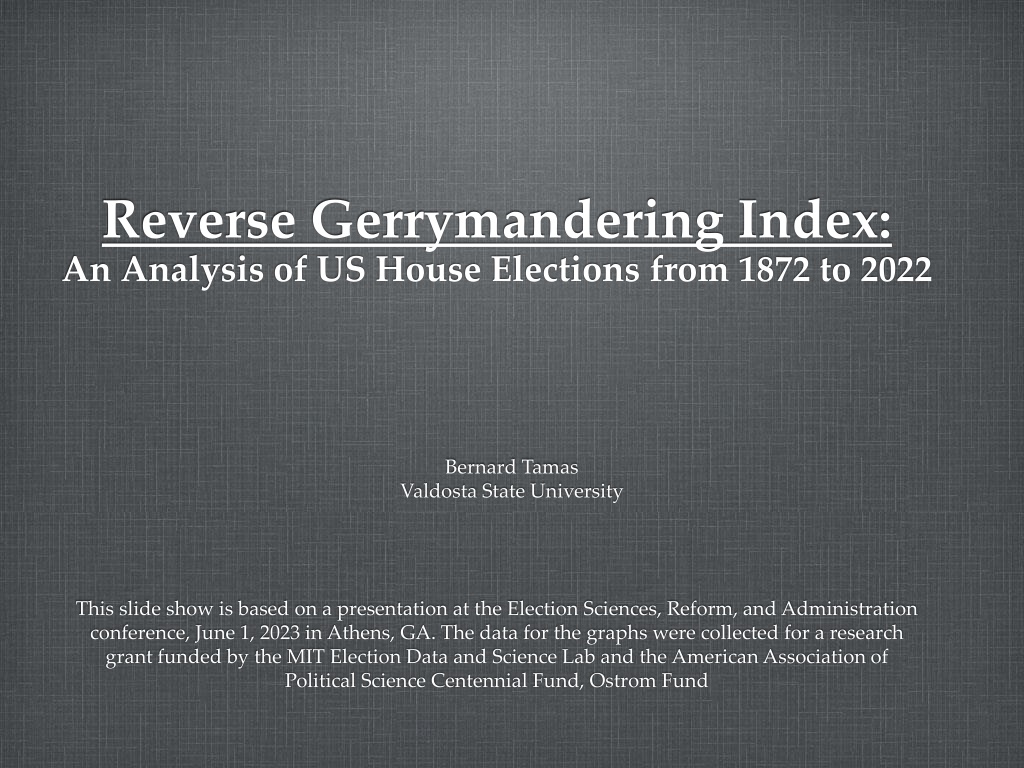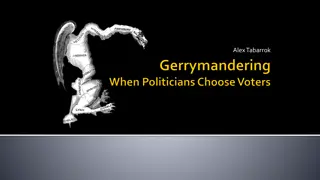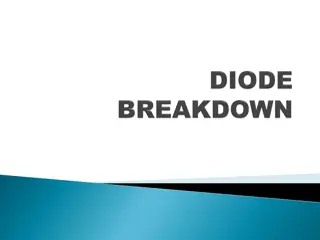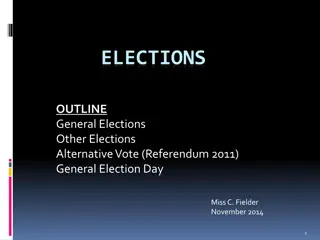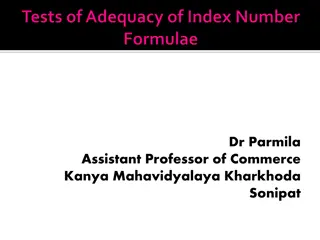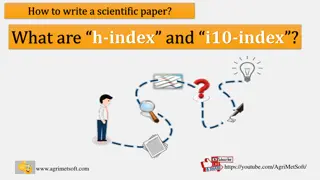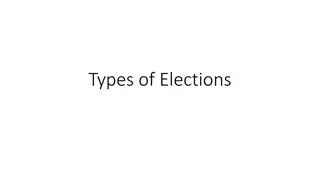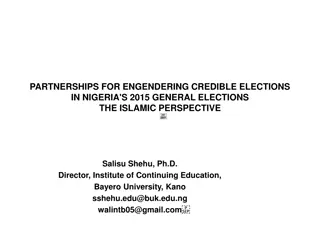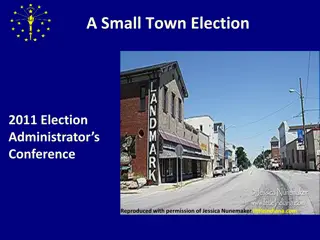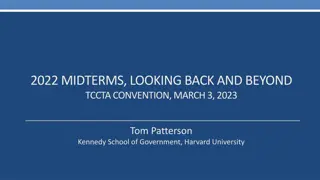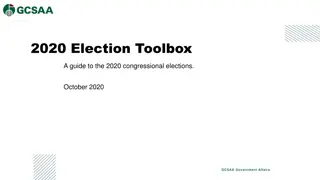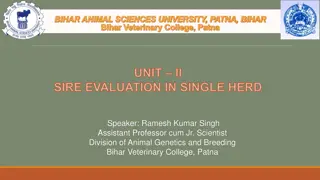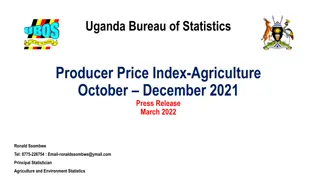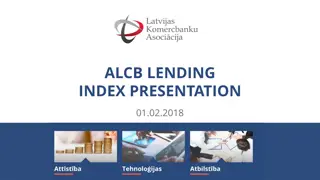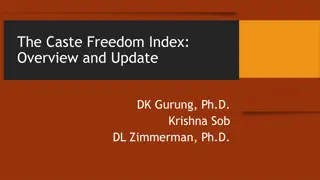Analysis of Reverse Gerrymandering Index in US House Elections
This presentation discusses the Reverse Gerrymandering Index (RGIx) as a tool to analyze gerrymandering in US House elections from 1872 to 2022. It explains the concept of RGIx, how it functions to reverse packing, its advantages, and how it provides district-level scores unaffected by statewide variations. RGIx aims to minimize partisan differences between neighboring districts to combat gerrymandering effectively.
Download Presentation

Please find below an Image/Link to download the presentation.
The content on the website is provided AS IS for your information and personal use only. It may not be sold, licensed, or shared on other websites without obtaining consent from the author. Download presentation by click this link. If you encounter any issues during the download, it is possible that the publisher has removed the file from their server.
E N D
Presentation Transcript
Reverse Gerrymandering Index: An Analysis of US House Elections from 1872 to 2022 Bernard Tamas Valdosta State University This slide show is based on a presentation at the Election Sciences, Reform, and Administration conference, June 1, 2023 in Athens, GA. The data for the graphs were collected for a research grant funded by the MIT Election Data and Science Lab and the American Association of Political Science Centennial Fund, Ostrom Fund
Introduction Current Measures of Gerrymandering Current measures: Vote/Seat Patterns (e.g., Efficiency Gap) Examine variations in vote across all districts in state/country as evidence of gerrymandering. (Other factors, like high concentration of Democrats in urban areas, can also cause these patterns.) District shapes (e.g., Polsby-Popper) The less compact a district, the more gerrymandered. (New technology has made it easier for states to create gerrymandered districts that are compact.) Monte Carlo approach to drawing district lines (This is a powerful approach but requires significant subdistrict data, like precinct or block-level partisanship, which is not always available.)
Introduction Reverse Gerrymandering Index (RGIx) The underlying logic of RGIx: Gerrymandering is caused by drawing district lines so that there are partisan difference of districts next to each other. Packing: Many supporters of one party packed into a district different than adjacent districts Classic example: North Carolina 12th in 2012: o The district itself had 80% Democratic vote o All the surrounding districts: 39%, 42%, 43%, 46%, and 47% Democratic vote. This creates a situation in which the Democratic Party wins NC-12th while the Republicans win all the surrounding districts, creating a net gain for the Republican Party.
Introduction Reverse Gerrymandering Index RGIx functions by trying to reverse this packing It flattens the vote differences of neighboring districts by moving voters randomly to either their current or neighboring districts. In this way, the many Democratic voters would be moved from NC-12 to neighboring districts while many Republican voters in neighboring districts would be moved into NC-12. This would reduce the vote differences across neighboring districts, create an expected vote had there been no packed district. 1. For each district, the difference between actual and expected would produce an RGIx score, which is a measure of its level of packing 2. Those RGIx scores can then be used for analyzing gerrymandering levels 3.
Introduction Reverse Gerrymandering Index RGIx produces a number of advantages: It creates an RGIx score for each district. (This is the most important difference between RGIx and some other measures that look at the vote differences across adjacent districts.) Those scores are influenced only by local differences. It does not confuse vote differences in districts on different side of a large state as gerrymandering Unlike some measures, it naturally handles small states. A state with one district gets an RGIx score of 0, for example, since that district has no neighbors. It requires limited data, only the vote distribution and what districts are next to each other. This is especially important for historical analysis and in countries that provide limited election data It can be used for multiparty electoral systems, not just two-party systems
Approach Graph Theory RGIx treats districts in each state as if they were part of a graph. Instead of thinking of gerrymandering as drawing district lines around voters, it flips the logic by treating each district as a set of voters and gerrymandering as shifting those voters to adjacent districts for political gain. Using graph theory, a district is a node (a circle), and districts next to each other are connected by an edge (a line). Traversing: Movement from one node to other RGIx randomly moves voters to either the same district or one next to it (i.e., traversing 0 or 1 step). This flattens the partisan differences across districts, reversing the gerrymandering
Approach An Example (Louisiana) The following slides show an example of this process, based on congressional districts in Louisiana, which has a highly packed district. The next slide shows the percent vote in each district translated into a graph, with each node showing the percent Democratic vote. (District 2, which is blue on the map, has 77.1% Democratic vote and is adjacent to Districts 1 and 6, which respectively have 25.7% and 25.0% Democratic vote. District 2 is clearly highly packed.)
Approach Districts to Graph Map: Graph: Actual vote
Approach An Example (Continued) Continuing the Louisiana example: RGIx then pretends that each district has 10,000 voters. Since District 2 has a 77.1% Democratic vote, RGIx assumes that it has 7710 Democrats and 2290 Republicans. The RGIx algorithm then systematically steps from district to district, randomly either keeping each of these 10,0000 voters in the same district or moving them to an adjacent district. The movement of these voters causes the differences between neighboring districts to shrink. In the next slide, the new percent vote after this movement of voters is shown on the left. The differences between the actual vote and the vote after this movement (the RGIx score) is shown on the right. The RGIx score, shown on the right, is the actual percent vote minus the percent vote after voters were shuffled. The RGIx score is high (25.9%) for LA-2. But for districts in the northwest of the state, like LA-4, the RGIx score is close to zero.
Approach Calculate RGIx Scores Expected Value: RGIx Score: After voters shuffled Actual minus expected vote
Analysis Reverse Gerrymandering Index Researchers can then apply the RGIx scores in various ways. For this presentation, I will use it to produce a simple analysis of packing I measure packing as an RGIx score of 10% or higher o 10% or greater is a pro-Republican packing. (In other words, it is when many Democratic voters are packed into one district.) o -10% or less is a pro-Democratic packing. (In other words, it is when many Republican voters are packed into one district.) I then use these scores to measure change in gerrymandering in US House elections from 1872 to 2022
Analysis Efficiency Gap To begin, as a point of comparison, in the next graph I show the measurement of gerrymandering using the efficiency gap, one of the most widely used measures of gerrymandering today By most accounts, gerrymandering was pretty rare in the early half of the twentieth century but became much more common after the Supreme Court ruled in the early 1960s that states must redraw district lines after each apportionment and give those districts equal population. Problem 1: As the next graph shows, the efficiency gap indicate dramatic movement in gerrymandering before these rulings and a reduction of gerrymandering in recent years Problem 2: The efficiency gap also shows wild movement from election to election, especially before the 1960s, even though it should be more stable.
Gerrymandering US House Efficiency Gap
Analysis RGIx: Partisan Imbalance The results for RGIx are more consistent with current understandings of the history of gerrymandering. At the same time, it adds to our current knowledge on the evolution of gerrymandering. The next graph shows which party benefited from gerrymandering each apportionment period. Each dot represents the percent of pro- Republican packs minus the percent of pro-Democratic packs. In the period before the Supreme Court ruled that states must make all districts equal in population, neither party had much advantage from gerrymandering After those Supreme Court rulings, the impact of gerrymandering began rising Starting in the 1980s, there was a dramatic shift in the Republican Party s favor due to gerrymandering.
Gerrymandering US House RGIx: Partisan Imbalance
Analysis RGIx: Packed Democratic and Republican Districts While this might give off the impression that Republican states have been heavily gerrymandering while Democratic states were not, the next graph shows a different story. Like the previous graph, this graph also shows that there was little gerrymandering before the 1960s. However, it also shows that the amount of gerrymandering was already rising in the 1950s, and more detailed analysis shows that there was further rise in 1962 and 1964, before the states had to redraw their district lines. Nonetheless, there was a rapid rise in the percent of packed districts starting in 1966.
Analysis RGIx: Packed Democratic and Republican Districts (continued) However, the number of pro-Democratic packed districts began dropping in the 1980s while the number of pro-Republican packed districts continued to rise. Starting after the 2000 apportionment, the number of pro- Republican packed districts also began declining. However, the pro-Democratic packed districts were also disappearing, which has been a critical reason for the most packed districts now favoring the Republican Party
Gerrymandering US House RGIx: Packed Democratic and Republican Districts
Analysis RGIx: Partisan Imbalance in South Finally, the last graph shows how the partisan imbalance caused by gerrymandering was different in the South compared to the rest of the country. It shows that most, but not all, of the gerrymandering advantage for the Republican Party comes from former Confederate states. Within the South, the Republican Party gains a substantial gerrymandering advantage. The graph also shows that starting in the 1950s pro-Democratic gerrymandering started increasing in the South, but that the Republican advantage began increasing dramatically in the 1990s.
Gerrymandering US House Partisan Imbalance in South
Conclusion Applications and Goals Because RGIx produces a gerrymandering score for each district, it can be applied a wide range of ways: It can be used to identify individual packed districts (district- level variable) Skew scores can be created for each state, to indicate which states are the most gerrymandered The RGIx scores can be used as either the dependent or an independent variable in multivariate analyses, such as to determine the relationship between race and partisan gerrymandering The RGIx score can also be altered to directly measure demographic gerrymandering, like racial gerrymandering.
Conclusion Applications and Goals Besides developing testing these various applications of RGIx, I also plan to: Make RGIx data for congressional elections publicly available Develop software (in Python and in an R package) that calculate scores for user.
